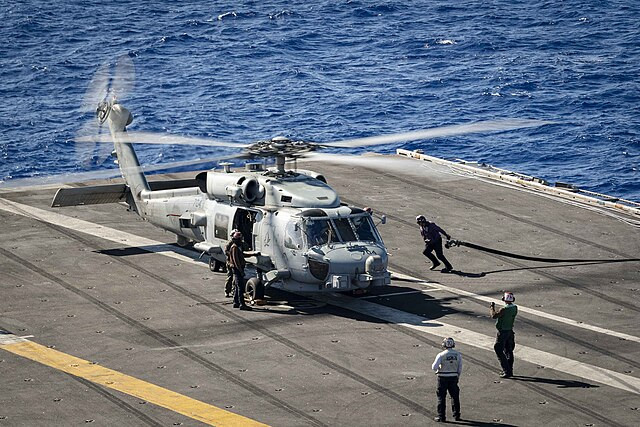Two U.S. Navy aircraft operating from the USS Nimitz crashed separately into the South China Sea on Sunday, sparking sharp criticism from Beijing and renewed scrutiny of U.S. military operations in one of the world's most volatile maritime regions.
The U.S. Pacific Fleet confirmed that a MH-60R Sea Hawk helicopter and an F/A-18F Super Hornet fighter jet went down within 30 minutes of each other during "routine operations" from the Nimitz. All five crew members were rescued and are in stable condition, the fleet said.
President Donald Trump, traveling to Japan as part of an Asia tour, described the twin incidents as "very unusual." Speaking aboard Air Force One on Monday, Trump said, "They think it might be bad fuel. We're going to find out. Nothing to hide."
Beijing quickly seized on the crashes to criticize Washington's military presence in the region. "The U.S. frequently dispatches warships and aircraft to the South China Sea to show off its military power, which is the root cause of maritime security issues and undermines regional peace and stability," Chinese foreign ministry spokesman Guo Jiakun said at a press briefing Monday. He added that China was "willing to provide assistance to the U.S. from a humanitarian perspective" if requested.
The South China Sea remains a flashpoint of great-power rivalry, with overlapping territorial claims from China, Vietnam, the Philippines, and Malaysia. Beijing asserts control over nearly all of the waterway, defying a 2016 international court ruling, and has expanded its network of military installations on artificial islands. The U.S., meanwhile, maintains that freedom of navigation in the area is essential to global trade and regional security.
Military analysts said the timing and location of the crashes were notable. "While it's very early days to determine what brought down both vehicles, the fact that two aircraft were brought down in short order in a deeply geostrategic and contested environment must be taken into account," said John Hemmings, deputy director for geopolitics at the U.K.-based Council on Geostrategy.
Matthew Savill, director of military sciences at the Royal United Services Institute, called the twin crashes "certainly unusual." He noted that carrier-based operations are "fearsomely complicated, especially on a big and busy one like the Nimitz," adding that "any number of small things can go wrong which can have dangerous consequences."
The Nimitz, the Navy's oldest active carrier, is scheduled for decommissioning next year after more than four decades of service. The two downed aircraft were operated by the "Battle Cats" of Helicopter Maritime Strike Squadron 73 and the "Fighting Redcocks" of Strike Fighter Squadron 22.
The F/A-18 crash marks at least the fourth loss of the $60 million fighter jet this year, following incidents in the Red Sea and off the Virginia coast. Analysts say the Navy is likely to conduct a thorough technical review, particularly as concerns rise over maintenance and digital vulnerabilities in aging fleet systems.
Dan Rice, a West Point graduate and president of American University Kyiv, said the Navy would be on high alert after the events. It is "odd for two aircraft to go down in separate instances, so close together in time," he told Newsweek.





